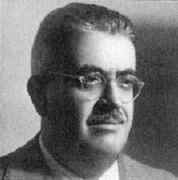Person: Miranda, Carlo

Carlo Miranda was an Italian mathematician who worked on mathematical analysis, partial differential equations and complex analysis.
Mathematical Profile (Excerpt):
- Carlo attended school in Naples, completing his secondary education at the age of fifteen.
- Miranda had not just been influenced by Picone while he studied at Naples, but he had also learnt much from Picone's assistant Renato Caccioppoli and from Caccioppoli's thesis advisor Ernesto Pascal.
- After graduating, Miranda became an assistant in infinitesimal calculus, supporting the chair of mathematics held by Picone.
- After a year working with this distinguished team of scholars, Miranda left Naples in 1932 with Picone when he moved his Institute to Rome on being appointed to the chair of Higher Analysis there.
- Miranda returned to Rome for the academic year 1935-36 when he was put in charge of teaching the theory of functions at the University of Rome.
- Miranda was teaching in Italy and the right age to be drafted into the army but he managed to avoid being called up.
- This was largely due to the efforts of Picone who made Miranda a consultant for the National Institute for the Applications of the Calculus (INAC) and argued that the Institute was vital for military research and therefore its staff (including consultants such as Miranda) must remain in post and not be drafted into the army.
- He had indicated in a report in 1938 that the Institute was undertaking important theoretical work, and here he emphasised Miranda's work on the calculus of variations and eigenvalue problems.
- Miranda continued to work at the Turin Polytechnic where he was promoted to full professor in 1941.
- Only two mathematicians, Miranda and Caccioppoli together with the astronomer Vittorio Nobile, were teaching there at this time, with one further mathematician, G Andreoli, suspended by the Allies because of his uncompromising adherence to fascism.
- However, Caccioppoli had no practical or organisational skills so it was left to Miranda, in his early thirties, to revive mathematics at the University of Naples on his own.
- The Institute began to operate from 1944, with Miranda as its director.
- The teaching load during the post-war years was particularly heavy for Miranda, since he restarted a full lecture programme with only Caccioppoli to assist with lectures and a few assistants in charge of exercise classes.
- However, between Miranda and Caccioppoli there was a profound scientific and human bond - they complemented each other perfectly due to their different character traits; both were brilliant but Caccioppoli was totally disorganised while Miranda was a superb organiser.
- He was able to take advantage of a special dispensation which allowed students to complete their degrees so he studied at Naples taught by Miranda and Caccioppoli.
- A scholarship enabled him to continue his research at the University of Naples under the supervision of Caccioppoli and Miranda, and he also undertook tutorial work to assist the Professor of Algebraic Analysis, although this was done on a voluntary basis.
- Stampacchia felt that contact with Caccioppoli and Miranda was important for him and Leonida Tonelli advised him to take a position as an assistant at the Naval Institute at Naples.
- In addition to teaching at the Naval Institute he taught at the University on a voluntary basis and was able to add to both the teaching there and to the vigorous research team which Miranda had begun to build at the Institute.
- Earlier than this, in 1949, Miranda had published his lecture notes for the academic year 1948-49 on Problemi di esistenza in analisi funzionale Ⓣ(Existence problems in functional analysis).
- Although Miranda was assisted by Caccioppoli in building a school of mathematics in Naples for over ten years, this tragically ended in 1959 with Caccioppoli's suicide.
- Miranda was, by this time, Dean of the Faculty of Sciences at Naples, a role he held for ten years from 1958.
- Miranda was honoured with election to the Accademia dei Lincei in 1968.
Born 15 August 1912, Naples, Italy. Died 28 May 1982, Naples, Italy.
View full biography at MacTutor
Tags relevant for this person:
Origin Italy
Thank you to the contributors under CC BY-SA 4.0! 

- Github:
-

- non-Github:
- @J-J-O'Connor
- @E-F-Robertson
References
Adapted from other CC BY-SA 4.0 Sources:
- O’Connor, John J; Robertson, Edmund F: MacTutor History of Mathematics Archive
